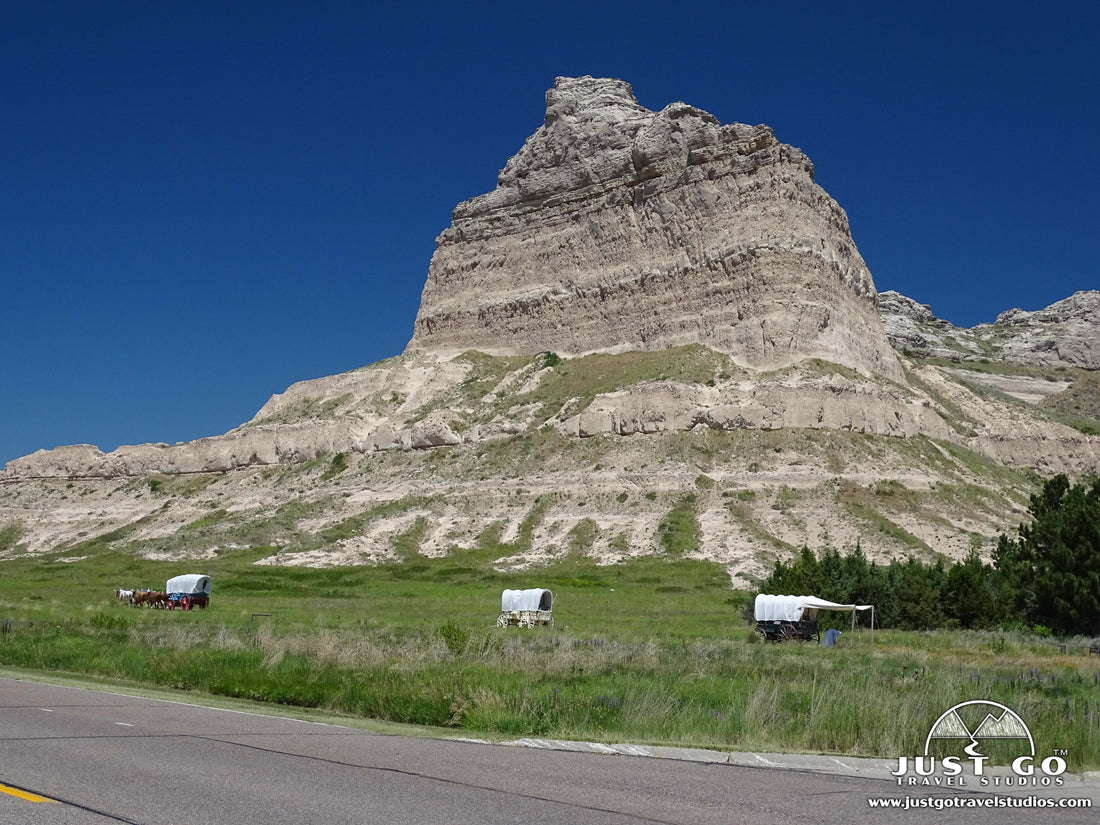
Scotts Bluff National Monument: Things to Do, Hiking Trails, Maps & More
Peter BrahanScotts Bluff National Monument in Nebraska may seem like an unlikely place to be seeking out, but the truth is that it was once the landmark dreamt about by many pioneers in the 1800’s during the westward expansion. While you may not be planning a vacation to Nebraska anytime soon, if you are in Wyoming, Colorado or South Dakota, then making a side trip to Scotts Bluff National Monument is more than worth the drive!
If you are coming to Scotts Bluff, then plan on spending a few hours roaming the grounds, taking in the scenery and learning about what this landmark meant to so many people that ventured on the Oregon Trail. We hope this guide gives you a few tips on what to expect during your visit!
SCOTTS BLUFF NATIONAL MONUMENT HISTORY
When those migrating to the west traveled on the Oregon Trail, there were several landmarks that they used to guide their way. Rising 800 feet above the surrounding landscape, it’s easy to see how Scotts Bluff was one of the most talked about landmarks (Chimney Rock was the most referred to landmark, which is 23 miles to the east-southeast). When travelers got here, it symbolized that one-third of the distance to Oregon was completed.
Over a quarter of a million people passed by this landmark on their way to the west. So many people followed the same route, in fact, that you can still see the wagon wheel marks on the paths they traveled! The number of travelers through the area declined starting in 1869, when the Transcontinental Railroad was finished.
To preserve the history of this location, Scotts Bluff was designated as a National Monument in 1919. The monument received a number or improvements over the years, but the largest was the construction of the roadway to the top of Scotts Bluff by the Civilian Conservation Corps, completed in the 1930’s. It has three tunnels, which are the only vehicular tunnels in the state of Nebraska.
THINGS TO DO IN SCOTTS BLUFF NATIONAL MONUMENT

When visiting Scotts Bluff National Monument, you’ll find a few things to do that should spark your interest. The good thing is that there isn’t much in the way of pre-planning that you have to do, as reservations are not needed, and the monument never gets too crowded. Our recommendations include the following:
Scotts Bluff National Monument Visitor Center
We like to start all our visits to parks with a stop in at the visitor center. The visitor center here is small, but it provides some great information about the history of the area as well as the geography. You can also view the William Henry Jackson collection. William Henry Jackson was a photographer that served in the Civil War. He lived until he was 99 years old, and photographed landscapes mainly and chronicled the growth and natural spaces of the American West. A selection of his work is on display here.
Scotts Bluff Summit Road
If you visit the park, then taking the 1.6-mile drive up the Summit Road is a must do. There are three tunnels on the way up. Once you get to the top, you have great views of the surrounding landscape. At the top of the road, you’ll have a chance to get out and stretch your legs a bit. The park closes the entrance to the road at 4:00 pm, and all vehicles must be off the road by 4:30 pm. Expect to spend between 30 and 60 minutes driving the road and checking out the viewpoints.
Hiking
If you happen to visit the monument when it’s not too hot, then hiking is a great option. There are a few trails that are worth checking out, and most of them are short and doable for the entire family, which we cover in detail in the next section.

HIKING TRAILS IN SCOTTS BLUFF NATIONAL MONUMENT
North Overlook Trail
- Difficulty: Easy
- Distance (round-trip): 0.6 miles
- Elevation gain: Minimal
- Hiking time (approximate): 30 minutes

North Overlook Trail map, courtesy of the National Park Service
For multiple good views, the North Overlook Trail is a fantastic option. This 0.6-mile (round-trip) trail provides views to the east as well as the town of Scottsbluff to the northeast. It’s flat and quite easy.
The North Overlook Trail starts from the end of the Summit Road on the north side of the parking lot.

South Overlook Trail
- Difficulty: Easy
- Distance (round-trip):3 miles
- Elevation gain: Minimal
- Hiking time (approximate): 15 minutes

South Overlook Trail map, courtesy of the National Park Service
The other hike from the summit is the South Overlook Trail. This flat, 0.3-mile (round-trip) hike gives good views of Mitchell Pass, the Visitor Center and parts of the Oregon Trail.
The South Overlook Trail starts on the south side of the parking area at the end of Summit Road.


Saddle Rock Trail
- Difficulty: Moderate
- Distance (round-trip): 3.0 miles
- Elevation gain: 550 feet
- Hiking time (approximate): 2 hours

Saddle Rock Trail map, courtesy of the National Park Service
For those in for a more intense hike, the Saddle Rock Trail travels 3-miles (round-trip) from the Visitor Center to the top of Scotts Bluff. The total elevation gain is about 550 feet. While that may not seem like a lot, the elevation gain happens over a distance of about 0.75 miles. The trail is paved, though as you get to the top the pavement is a bit rough. This is a good hike, but we recommend also taking the drive to the top if you can.
The trailhead begins from the Visitor Center.
Oregon Trail
- Difficulty: Easy
- Distance (round-trip): 1.0 miles
- Elevation gain: Minimal
- Hiking time (approximate): 30 to 45 minutes

Oregon Trail map, courtesy of the National Park Service
The Oregon Trail is another option. This short hike is more of a walk, but it travels 1.0-mile (round-trip) alongside the Studebaker, Conestoga and Murphy Wagons that are in front of the monument. These wagons were used for carrying people and supplies along the trail. There is some great information along the way for you to read.
The trail begins from the Visitor Center and travels to the northwest.
HOW TO GET TO SCOTTS BLUFF NATIONAL MONUMENT AND OTHER TRAVEL INFORMATION
If you have access to a car and plan on driving to Scotts Bluff National Monument, consider yourself lucky. Enjoy the fact that you can drive over bridges rather than fording rivers, have access to air conditioning and don’t have to worry about bugs eating you alive as you travel for days.
But in all seriousness, getting to Scotts Bluff is quite easy. The only challenge is time-it’s not too close to an interstate, so you’ll likely have to make a bit of a side trip to get here.
- If you are coming from Colorado, here are the directions from Denver, CO to Scotts Bluff National Monument. It’s about 200 miles and will take a bit over 3 hours, without accounting for traffic when you are trying to leave the greater Denver, CO area.
- If coming from the east, here are directions from Kansas City, MO to Scotts Bluff National Monument. This will take between 9 and 10 hours, but it’ll be much faster than taking it by wagon train!
ENTRANCE FEES AND REQUIRED PASSES FOR SCOTTS BLUFF NATIONAL MONUMENT
Scotts Bluff National Monument does not have any fees. You are free to enter the monument and enjoy!
WHERE TO STAY WHEN VISITNG SCOTTS BLUFF NATIONAL MONUMENT
Scotts Bluff National Monument Lodging: There is no lodging in the monument. The best option for lodging is in nearby Scottsbluff, NE.
SCOTTS BLUFF NATIONAL MONUMENT CAMPING
There is no camping inside Scotts Bluff National Monument, but there are plenty of campgrounds in the surrounding area.
BEST TIME TO VISIT SCOTTS BLUFF NATIONAL MONUMENT
Scotts Bluff National Monument is open nearly everyday of the year, with the exception of Christmas Day, New Year’s Day and Thanksgiving Day.
The weather in Scotts Bluff National Monument is mild in the winter, with highs generally in the mid-40’s or 50’s. The summer can be hot, and there is no shade. However, if the weather isn’t what you consider to be ideal, there is enough to do to keep you busy indoors (between the drive to the summit and the Visitor Center).
Crowds are never an issue, though it is busier in the summer months of the year.
ARE PETS ALLOWED IN SCOTTS BLUFF NATIONAL MONUMENT?
Pets are allowed in Scotts Bluff National Monument, as long as they are kept on a leash and only on paved trails. Bags are available at the trailheads to clean up if your animal leaves waste near the trail.
RELATED INFORMATION ON SCOTTS BLUFF NATIONAL MONUMENT AND THE SURROUNDING AREA FROM JUST GO TRAVEL STUDIOS
- Only about an hour to the north is Agate Fossil Beds National Monument. We were very impressed with this park, and recommend you check it out!
- Once you return from your trip, let us create a custom, vintage travel poster from a photo that you send to us! It’s our signature product that we know you’ll love!



